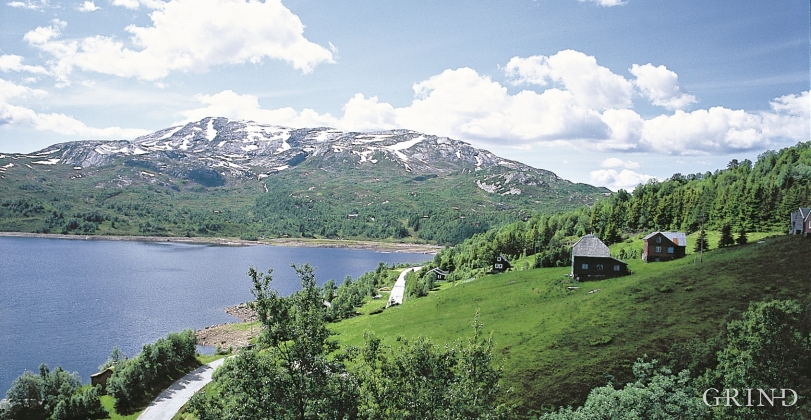Published: 10.08.2015 | Author: Haakon Fossen
Kjerringafjellet Mountain on the horizon is built up of rock types from the Lower Bergsdal Complex. At Grønestad in the foreground, there is phyllite in the green hillsides. (Svein Nord)
When the enormous sheet of bedrock came creeping in over the Precambrian basement rock in Hordaland, at a speed of perhaps a few centimetres per year, it had already completed a trip from the west or northwest of several tens of kilometres or more. The reshuffling of the crust is due to the strong forces that pushed Norway and Greenland together: the Caledonian mountain building event.
The lowermost of these thrust sheets, consisting of the Lower and Upper Bergsdal complex, is well preserved in the Bergdal area and further toward Kvamskogen and Vossfjella. It was professor Anders Kvale who named these thrust sheets and who made Bergsdalen internationally famous among a generation of geologists. Kvale argued that the sheet had moved toward the east, away from the collision zone. This theory is still widely accepted. Later research on the Bergsdal thrust sheet has nonetheless revealed that the transport story is more complicated than Kvale thought. It is now believed that the sheet wandered westward again, after the easterly transport was completed. The return trip occurred after the continental collision was over and the power of the collision had ebbed out.
The counter effect of the first movement can be compared to what happens when a large toboggan gets shoved up a snowy hill. When the pushing force is removed, the toboggan will slide back, until it gets stuck in the snow. When the Bergsdal thrust sheet slid back west, the entire layer of rock got tilted slightly toward the west or northwest, in the direction it slid. Just after the thrust sheet got stuck in the "snow", the underlying layer of rock became rotated, such that it now tilts toward the southeast.
Skyvedekke
A thrust sheet is a large flake of bedrock that was torn loose and shoved many kilometres from its source. This was formed when the earth's crust was compressed together during mountain-building, and was piled at a great height. In many cases one type of bedrock would glide over another that was softer and weaker, such as the phyllite in South Norway, which functioned as a gliding plane.
Profile and terrain model showing geological units; Precambrian basement, phyllite, and Upper and Lower Bergdal Complex, for the area north of a line between Osterøy and Hardanger. Bergdal Complex is also basement rock, but this basement got transported during the Caledonian mountain-building event and can be distinguished from the underlying basement. Red colour: granite, gabbro and similar magmatic rocks; orange colour: quartzite and altered lava rock types. (Haakon Fossen)
- Fossen, H. 1993. Structural evolution of the Bergsdalen Nappes, Southwest Norway. Norges Geologiske Undersøkelse 1993, 424,23–50.
- Kvale, A. 1946–47. Petrologic and structural studies in the Bergsdalen quadrangle, western Norway. Bergen Museums Årbok 1946–47, Naturvit.rekke,1.





